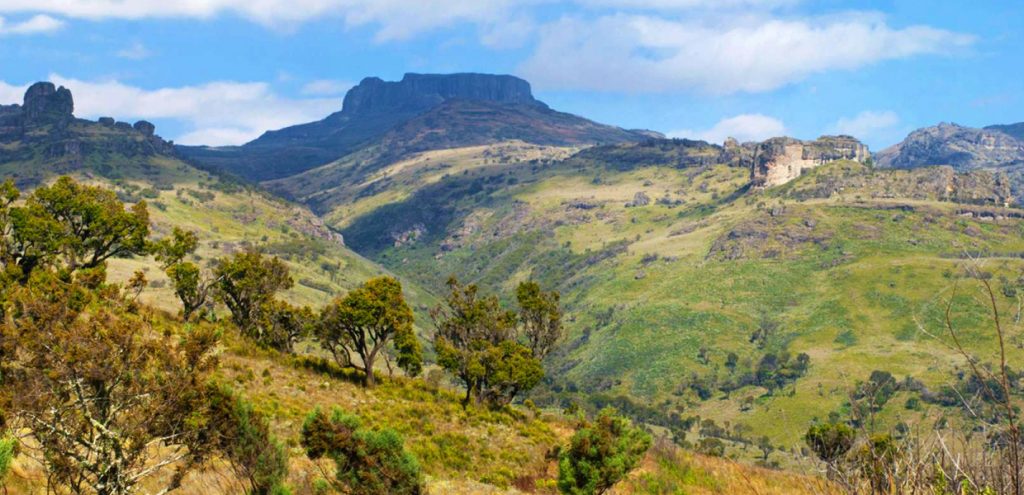If you’re searching for quick facts about Mount Elgon National Park, we’ve got you covered. Mount Elgon is a massive solitary volcanic mountain on the border of eastern Uganda and western Kenya in East Africa. Its vast form, 80 kilometers (50 mi) in diameter, rises more than 3,070 meters (10,070 ft) above the surrounding plains. Its cooler heights offer respite for humans from the hot plains below, and its higher altitudes provide a refuge for flora and fauna.
Mount Elgon is an extinct volcano and one of Uganda’s oldest physical features, estimated to first erupt around 24 million years ago. Mount Elgon has the largest surface area of any extinct volcano in the world (50km by 80km), and the second-highest peak in Uganda (Wagagi Peak – 4,321 meters). The mountain contains a crater (caldera) covering over 40km at the top of the mountain, surrounded by a series of rugged peaks.
It was once Africa’s highest mountain, far exceeding Kilimanjaro at 5,895m, but millennia of erosion reduced its height to 4,321m currently. This relegated it to the 4th highest peak in East Africa and 8th on the continent.

Although there is no verifiable evidence of its earliest volcanic activity, geologists estimate that Mount Elgon is at least 24 million years old, making it the oldest extinct volcano in East Africa. Its cool heights offer respite for humans from the hot plains below and its higher altitudes provide diverse habitats for flora and fauna.
The mountain is the catchment area for several rivers such as the Suam River, which becomes the Turkwel downstream, and drains into Lake Turkana, and the Nzoia River and the Lwakhakha River, which flow to Lake Victoria.
About Mount Elgon National Park
Mount Elgon National Park is named after Mount Elgon, an extinct shield volcano on the border of Uganda and Kenya, north of Kisumu and west of Kitale.
The Ugandan part of the park was gazetted in 1992, while the Kenyan part was gazetted much earlier in 1968. The entire park was declared a UNESCO Biosphere Reserve. The park has a variety of wildlife, including birdlife, as a result, it provides great volcano climbing opportunities. It is the perfect destination for an African safari.
The area around the mountain is protected by two Mount Elgon National Parks, one on each side of the international border. Mount Elgon National Park is uniquely split down the middle by the Kenyan-Ugandan border. The entire national park is managed by two wildlife agencies; Uganda Wildlife Authority (UWA) in Uganda and Kenya Wildlife Service (KWS), on the Kenyan side.
Ngwarisha, Makingeny, Chepnyalil, and Kitum caves: Kitum Cave is over 60 meters (200 ft.) wide and penetrates 200 meters (660 ft.). The cave contains salt deposits and it is frequented by wild savannah elephants that lick the salt exposed by gouging the walls with their tusks. It became notorious following the publication of Richard Preston’s book, ‘The Hot Zone in 1994’, for its association with the Marburg virus after two people who had visited the cave (one in 1980 and another in 1987) contracted the disease and died.
First Explorers of Mount Elgon
Although Mount Elgon was well known to Arab traders passing along the old slave routes to its east in Kenya, the celebrated explorer Henry Morton Stanley was the first to write about Mount Elgon when he presumably saw it while circumnavigating Lake Victoria in 1875.
Joseph Thompson, a British explorer and geographer was the first European to actually visit the central massif in 1883. Thompson referred to the mountain as ‘Masawa’ or “Elgon” and generated curiosity among the explorers.
In 1890, with a 400-man caravan, Frederick Jackson of the Imperial British East Africa Company (IBEACO) was the first European to visit Mount Elgon’s caldera and to climb any of the major peaks. Ironically, Jackson climbed from the south and probably never even saw the summit of Masaba peak, which was later named Jackson’s Summit after him.
Summarized Facts About Mount Elgon
Quick Facts:
| Highest elevation | 4,321 meters (14,177 ft) |
| Rank | 4th in East Africa, 8th in Africa |
| Prominence | 2,458 m (8,064 ft) |
| Isolation | 339 km (211 mi) |
| Coordinates | 01°07′06″N 34°31′30″E |
Mt. Elgon Consists of Five Major Peaks:
| Peak | Elevation | Country |
| Wagagai | 4,321 meters (14,177 ft) | Uganda |
| Sudek | 4,302 meters (14,114 ft) | Kenya/Uganda border |
| Koitobos | 4,222 meters (13,852 ft) | flat-topped basalt column in Kenya |
| Mubiyi | 4,211 meters (13,816 ft) | Uganda |
| Masaba | 4,161 meters (13,652 ft) | Uganda |
Other features of note are:
- Sudek and Lower Elgon from the Old Elgon Hut, burned down 1975, on the Kimilili approach
- The Sacred Lake, just outside the crater rim and below Sudek
- The caldera — Elgon’s is one of the largest intact calderas in the world.
- The warm springs by the Suam River
- Endebess bluff (2,563 meters (8,409 ft)
After visiting Mount Elgon National Park, Uganda is such a blessed destination that you can explore as a beautiful garden. You can make your way to Murchison Falls National Park, one of Uganda’s spectacular wildlife safari park, to encounter the big five on your lucky day. Don’t miss the amazing boat cruise amidst the aquatic life and countless bird species. Further west, you can’t afford to miss the lifetime gorilla trekking safari in Bwindi Impenetrable and Mgahinga Gorilla National Parks.
